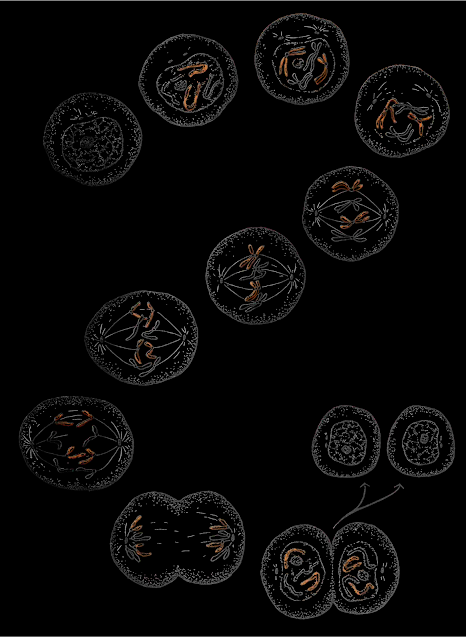The series of changes that a cell undergoes from the time it is formed until it reproduces is called its life cycle. Superficially, this cycle seems rather simple—a newly formed cell grows for a time and then splits in half to form two daughter cells. Yet the details of the cycle are quite complex. Growth, for example, requires that the young cell obtain nutrients from its surroundings, utilize them in the manufacture of new living materials, and synthesize many vital compounds.
 |
| Cell Cycle |
Mitosis
Cell reproduction involves the dividing of a cell into two portions and includes two separate processes:
- Division of the nuclear parts, which is called mitosis (karyokinesis).
- Division of the cytoplasm (cytokinesis).
Division of the nuclear parts by mitosis is, of necessity, very precise, since the nucleus contains information, in the form of DNA molecules, that "tells" cell parts how to function. Each daughter cell must have a copy of this information in order to survive.
 |
| Mitosis |
Thus, the DNA molecules of the parent cell must be duplicated, and the duplicate sets must be distributed equally to the daughter cells. Once this has been accomplished, the cytoplasm and its parts can be divided. Although mitosis is often described in terms of stages, the process is really a continuous one without marked changes between one step and the next. The idea of stages is useful, however, to indicate the sequence in which major events occur.
These stages include the following:
Prophase
One of the first indications that a cell is going to reproduce is the appearance of chromosomes. These structures form from chromatin in the nucleus as chromatin threads condense into tightly coiled, rodlike parts. The resulting chromosomes contain DNA and protein molecules. Sometime earlier (during interphase,) the DNA molecules became duplicated, and each chromosome is consequently composed of two identical portions (chromatids), which temporarily remain fastened together. The centrioles of the centrosome move apart and travel to opposite sides of the cytoplasm. Soon the nuclear membrane and the nucleolus disappear. Microtubules (spindle fibers) form in the cytoplasm, and they become associated with the centrioles and chromosomes.
 |
| Prophase |
Metaphase
The chromosomes become lined up in an orderly fashion about midway between the centrioles, apparently as a result of microtubule activity. Microtubules also are attached to the chromosome parts so that a microtubule accompanying one centriole is attached to one part of a chromosome, while a microtubule accompanying the other centriole is attached to the other part. Soon the identical chromosome parts, which have been fastened together, become separated as individual chromosomes.
 |
| Metaphase |
Anaphase
The separated chromosomes now move in opposite directions, and once again, the movement seems to result from microtubule activity. In this case, the microtubules appear to shorten and pull their attached chromosomes toward the centrioles at opposite sides of the cell.
 |
| Anaphase |
Telophase
This final stage of mitosis is said to begin when the chromosomes complete their migration toward the centrioles. It is much like prophase, but in reverse. As the chromosomes approach the centrioles, they begin to elongate and change from rodlike into threadlike structures. A nuclear membrane forms around each chromosome set, and nucleoli appear within the newly formed nuclei. Finally, the microtubules disappear and the centrioles become duplicated. Telophase is accompanied by cytoplasmic division in which the cytoplasm is split into two portions.
 |
| Telophase |
Cytoplasmic Division
The mechanism responsible for cytoplasmic division (cytokinesis) is not well understood, but the cell membrane begins to constrict during telophase and then pinches inward between the daughter nuclei. As a result, about half the cytoplasmic organelles are distributed to each new cell. Although the newly formed cells may differ slightly in size and number of cytoplasmic parts, they have identical chromosomes and thus contain identical DNA information. Except for size, they are copies of the parent cell.
 |
| Cytoplasmic Division |
Interphase
Once formed, the daughter cells usually begin growing. At the same time, various cell parts become duplicated. In the nucleus, the chromosomes may be doubling (at least in cells that will soon reproduce); and in the cytoplasm, new ribosomes, lysosomes, mitochondria, and membranes are appearing. This stage in the life cycle is called interphase, and it lasts until the cell begins to undergo mitosis. Many kinds of cells within the body are constantly growing and reproducing. Such activity is responsible for the growth and development of an embryo into a child, and a child into an adult. It is also responsible for the replacement of cells that are worn out or lost due to injury or disease.
0 comments:
Post a Comment